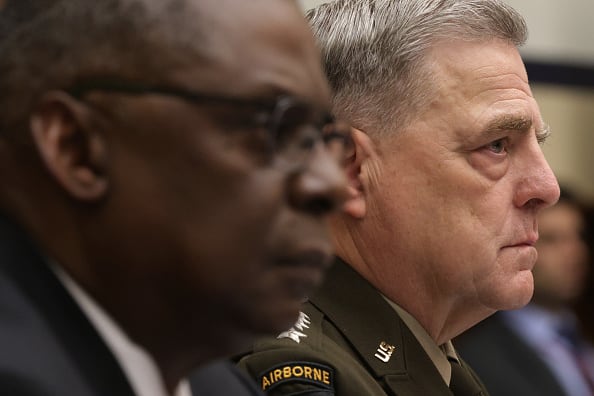WASHINGTON ― Tweaking President Joe Biden’s Pentagon spending request for next year, House appropriators have proposed $1.7 billion more for weapons procurement and $1.6 billion less for development and testing of cutting-edge technologies meant to deter China.
The House Appropriations Committee on Tuesday morning released its fiscal 2022 Pentagon-funding bill, which proposes $706 billion in defense spending, or roughly $10 billion above the amount enacted for the current fiscal year. When added to the $11 billion for military construction appropriators are seeking separately, that sets it about even with Biden’s $716 billion request.
The legislation, crafted by Democrats, includes $134.3 billion for procurement, which is $2.2 billion less than the current year’s budget. For research funding, appropriators are proposing $110.4 billion, which is $3.2 billion above the current year’s budget.
Appropriators were expected to tailor Biden’s request, but at first blush the bill doesn’t appear to include any major pushback against the administration’s strategy of divesting from legacy platforms to reinvest in cutting-edge technologies.
For the Navy, the bill adds a second Arleigh Burke-class destroyer sought widely by lawmakers, and it cuts one of two towing, salvage and rescue ships. Otherwise, it matches Biden’s two Virginia-class attack submarines, one Constellation-class frigate, one John Lewis-class fleet oiler and the one ocean surveillance ship.
RELATED

The Biden administration’s omission of the second destroyer was controversial on Capitol Hill because without it, the Navy cannot meet its obligation under multiyear contracts with both Ingalls Shipbuilding and General Dynamics’ Bath Iron Works. Those contracts call for each of the companies to build one ship in FY22.
If passed into law, the bill would stymie the Navy’s request to retire three littoral combat ships with some restrictive language: “None of the funds made available by this Act may be obligated or expended for the purpose of decommissioning the USS Fort Worth, the USS Detroit, or the USS Little Rock.”
All told, appropriators propose the same number of ships as Biden — eight — but they add $915 million above the Navy’s budget request.
For aircraft, the bill would add 12 F/A-18E/F Super Hornets, of which the administration sought none; four C/KC/MC-130J tankers for 134 total; six MQ-9 Reaper drones for 12 total; $170 million for the second and third set of five CH-47F Block II Chinook helicopters; three UH/HH-60M Black Hawk helicopters for 33 total; and two CH-53K helicopters for 11 total.
It matches Biden’s request for 85 F-35 Joint Strike Fighters, 12 F-15EX aircraft and 14 KC-46 tankers, plus assorted helicopters. The Air Force’s unfunded priorities list conspicuously omitted additional Lockheed Martin-made F-35s, but it did want another 12 Boeing F-15EXs to help narrow a projected gap as the service divests its aging F-15C/D fleet.
Wading into controversy around nuclear modernization, the bill matches the Navy’s decision to shelve its sea-launched nuclear cruise missile. While the decision was been cheered by arms control advocates and some lawmakers, it’s come under tough scrutiny from Republicans, who argue the move should be subject to the rigor of the administration’s upcoming Nuclear Posture Review.
At the same time, appropriators would provide $2.5 billion to develop the Ground Based Strategic Deterrent, which is the next-generation intercontinental ballistic missile, as well as $581 million for the Long Range Standoff Weapon, a new air-launched cruise missile.
The bill includes the administration’s 2.7 percent pay raise but takes sharper aim at personnel costs, trimming $488 million from the request for a total of $167 billion.
The bill also gets rid of the much-criticized overseas contingency operations account, like the Biden request.
“The Defense Appropriations bill provides resources requested by the Secretary of Defense to protect our national security, maintain a strong industrial base to support good paying jobs, and counter the rising threats from our adversaries, including China,” House Appropriations Committee Chairwoman Rosa DeLauro, D-Conn., said in a statement. “As it protects our nation, it also honors the soldiers and civilians who serve and support our nation’s military by providing for them and their families. This includes strong funding to combat sexual assault in the military, a serious and pervasive problem that for too long has been overlooked by the Pentagon.”
The legislation includes a number of policy provisions likely to spark partisan debate, like ordering the closure the detention facility at Guantanamo Bay by Sept. 30, 2022; requiring contractors to pay a $15 minimum wage; and barring support for the Saudi-led coalition’s offensive military operations in Yemen.
A partisan fight over the top line has been brewing for months, as key conservatives ― including the defense subpanel’s top Republican, California Rep. Ken Calvert ― have called for a 3-5 percent increase above inflation. Progressive Democrats are expected to push for cuts ― a move moderate Democrats are resisting.
The Appropriations Committee’s defense subpanel will take up the FY22 spending bill in a closed session on Wednesday.
Joe Gould was the senior Pentagon reporter for Defense News, covering the intersection of national security policy, politics and the defense industry. He had previously served as Congress reporter.







